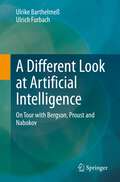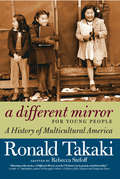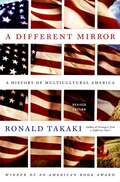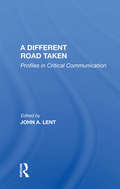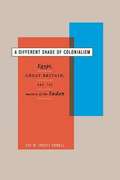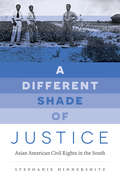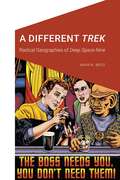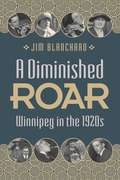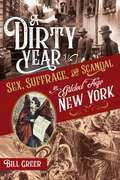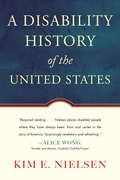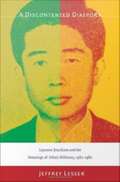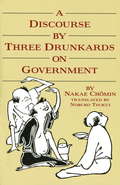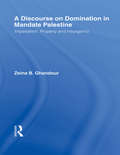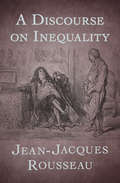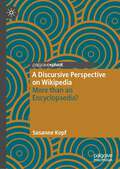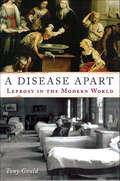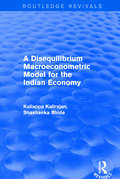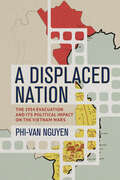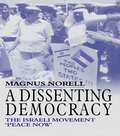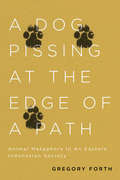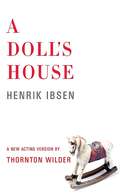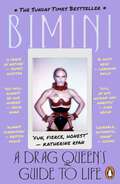- Table View
- List View
A Different Look at Artificial Intelligence: On Tour with Bergson, Proust and Nabokov
by Ulrich Furbach Ulrike BarthelmeßDigitalization is inexorably conquering our lives - also with artificial intelligence (AI) methods. Search engine operators, social network operators and shipping platform operators know more and more about us, about our buying and living habits. User data has become a valuable commodity. We live and work with computer systems that behave intelligently or are even intelligent. Questions like "Can machines be intelligent?" or "Can they have emotions or a consciousness?" keep popping up. To enable readers to form their own opinion on these questions, the authors clearly explain individual techniques or methods of AI and relate them to approaches from philosophy, art and neurobiology. Topics such as logical reasoning, knowledge and memory play just as important a role as machine learning and artificial neural networks. In the foreground is the question of what constitutes memory and thinking, what role our emotions play when we as humans move through life, through the world. A book that offers unusual perspectives on artificial intelligence.
A Different Mirror for Young People: A History of Multicultural America (For Young People Series)
by Rebecca Stefoff Ronald TakakiA longtime professor of Ethnic Studies at the University of California at Berkeley, Ronald Takaki was recognized as one of the foremost scholars of American ethnic history and diversity. When the first edition of A Different Mirror was published in 1993, Publishers Weekly called it "a brilliant revisionist history of America that is likely to become a classic of multicultural studies" and named it one of the ten best books of the year. Now Rebecca Stefoff, who adapted Howard Zinn's best-selling A People's History of the United States for younger readers, turns the updated 2008 edition of Takaki's multicultural masterwork into A Different Mirror for Young People. Drawing on Takaki's vast array of primary sources, and staying true to his own words whenever possible, A Different Mirror for Young People brings ethnic history alive through the words of people, including teenagers, who recorded their experiences in letters, diaries, and poems. Like Zinn's A People's History, Takaki's A Different Mirror offers a rich and rewarding "people's view" perspective on the American story.
A Different Mirror: A History of Multicultural America
by Ronald TakakiTakaki (emeritus, ethnic studies, U. of California-Berkeley) takes the perspective of ethnic, racial, and national minorities to recount the history of the US since the founding of the first English colony in 1607. The first edition won an American Book Award in 1993. This second incorporates new passages on Franklin Roosevelt's response to the Holocaust, the influx of Southeast Asian immigrants after the Vietnam War, and people pushed northward by poverty in Mexico.
A Different Road Taken: Profiles In Critical Communication
by John A LentDallas Smythe, George Gerbner, Herbert Schiller, James Halloran, Kaarle Nordenstreng- these five seminal figures form the backbone of current scholarship in critical communication. From policy research to television demographics and from economic globalization to cultural imperialism, their insights and discoveries have given both scholars and the
A Different Shade of Colonialism: Egypt, Great Britain, and the Mastery of the Sudan
by Eve M. Troutt PowellEve M. Troutt Powell challenges many accepted tenets of the binary relationship between European empires and non-European colonies by examining the triangle of colonialism marked by Great Britain, Egypt, and the Sudan.
A Different Shade of Justice: Asian American Civil Rights in the South (Justice, Power, and Politics)
by Stephanie HinnershitzIn the Jim Crow South, Chinese, Filipino, Japanese, and, later, Vietnamese and Indian Americans faced obstacles similar to those experienced by African Americans in their fight for civil and human rights. Although they were not black, Asian Americans generally were not considered white and thus were subject to school segregation, antimiscegenation laws, and discriminatory business practices. As Asian Americans attempted to establish themselves in the South, they found that institutionalized racism thwarted their efforts time and again. However, this book tells the story of their resistance and documents how Asian American political actors and civil rights activists challenged existing definitions of rights and justice in the South.From the formation of Chinese and Japanese communities in the early twentieth century through Indian hotel owners' battles against business discrimination in the 1980s and '90s, Stephanie Hinnershitz shows how Asian Americans organized carefully constructed legal battles that often traveled to the state and federal supreme courts. Drawing from legislative and legal records as well as oral histories, memoirs, and newspapers, Hinnershitz describes a movement that ran alongside and at times intersected with the African American fight for justice, and she restores Asian Americans to the fraught legacy of civil rights in the South.
A Different Trek: Radical Geographies of Deep Space Nine (Cultural Geographies + Rewriting the Earth)
by David K. SeitzA different kind of Star Trek television series debuted in 1993. Deep Space Nine was set not on a starship but a space station near a postcolonial planet still reeling from a genocidal occupation. The crew was led by a reluctant Black American commander and an extraterrestrial first officer who had until recently been an anticolonial revolutionary. DS9 extended Star Trek&’s tradition of critical social commentary but did so by transgressing many of Star Trek&’s previous taboos, including religion, money, eugenics, and interpersonal conflict. DS9 imagined a twenty-fourth century that was less a glitzy utopia than a critical mirror of contemporary U.S. racism, capitalism, imperialism, and heteropatriarchy. Thirty years after its premiere, DS9 is beloved by critics and fans but remains marginalized in scholarly studies of science fiction. Drawing on cultural geography, Black studies, and feminist and queer studies, A Different &“Trek&” is the first scholarly monograph dedicated to a critical interpretation of DS9&’s allegorical world-building. If DS9 has been vindicated aesthetically, this book argues that its prophetic, place-based critiques of 1990s U.S. politics, which deepened the foundations of many of our current crises, have been vindicated politically, to a degree most scholars and even many fans have yet to fully appreciate.
A Diminished Roar: Winnipeg in the 1920s
by Jim BlanchardThe third instalment in Jim Blanchard’s popular history of early Winnipeg, "A Diminished Roar" presents a city in the midst of enormous change. Once the fastest growing city in Canada, by 1920 Winnipeg was losing its dominant position in western Canada. As the decade began, Winnipeggers were reeling from the chaos of the Great War and the influenza pandemic. But it was the divisions exposed by the 1919 Winnipeg General Strike which left the deepest marks. As Winnipeg wrestled with its changing fortunes, its citizens looked for new ways to imagine the city’s future and identity. Beginning with the opening of the magnificent new provincial legislature building in 1920, A Diminished Roar guides readers through this decade of political and social turmoil. At City Hall, two very different politicians dominated the scene. Winnipeg’s first Labour mayor, S.J. Farmer, pushed for more public services. His rival, Ralph Webb, would act as the city’s chief “booster” as mayor, encouraging U.S. tourists with the promise of“snowballs and highballs.” Meanwhile, promoters tried to rekindle the city’s spirits with plans for new public projects, such as a grand boulevard through the middle of the city, a new amusement park, and the start of professional horse racing. In the midst of the Jazz Age, Winnipeg’s teenagers grappled with “problems of the heart,” and social groups like the Gyro Club organized masked balls for the city’s elite.
A Dirty South Manifesto: Sexual Resistance and Imagination in the New South (American Studies Now: Critical Histories of the Present #10)
by L.H. StallingsFrom the shutdown of Planned Parenthood clinics and rising rates of HIV to opposition to marriage equality and bathroom bills, the New South is the epicenter of the new sex wars. Antagonism toward reproductive freedom, partner rights, and transgender rights has revealed a new and unacknowledged era of southern reconstruction centered on gender and sexuality. In A Dirty South Manifesto, L. H. Stallings celebrates the roots of radical sexual resistance in the New South—a movement that is antiracist, decolonial, and transnational. For people within economically disenfranchised segments of society, those in sexually marginalized communities, and the racially oppressed, the South has been a sexual dystopia. Throughout this book, Stallings delivers hard-hitting manifestos for the new sex wars. With her focus on contemporary Black southern life, Stallings offers an invitation to anyone who has ever imagined a way of living beyond white supremacist heteropatriarchy.
A Dirty Year: Sex, Suffrage, and Scandal in Gilded Age New York
by Bill GreerAs 1872 opened, the New York Times headlined four stories that symptomized the decay in public morals that the editors so frequently decried: financier Jim Fisk was gunned down in a love triangle; suffragist and free-love advocate Victoria Woodhull was running for president; anti-vice activist Anthony Comstock battled smut dealers poisoning children's minds; and abortionists were thriving. Throughout the year these stories intertwined in unimaginable ways, pulling in others, both famous and infamous—suffragists Susan B. Anthony and Elizabeth Cady Stanton; Brooklyn's beloved preacher Henry Ward Beecher; the nation's richest tycoon, Cornelius Vanderbilt; and William Howe, preeminent counsel to the criminal element. From rigged elections, everyday shootings, and attacks on the press to sexual impropriety, reproductive rights, and the chasm between rich and poor, the issues of the day still resonate. Political parties split over a bitterly contested election; suffragist battled suffragist over bettering women's place in society; and pious saints fought soulless sinners, until at year-end this jumble of conflicts exploded in the greatest sensation of the nineteenth century.
A Disability History of the United States (REVISIONING HISTORY #2)
by Kim E. NielsenThe first book to cover the entirety of disability history, from pre-1492 to the present <P><P>By placing the experiences of people with disabilities at the center of the American story, A Disability History of the United States fundamentally reinterprets how we view our nation's past. Throughout the book Kim Nielsen illustrates how concepts of disability have deeply shaped the American experience--from deciding who was allowed to immigrate to establishing labor laws and justifying slavery and gender discrimination. <P><P>The book abounds with compelling stories pulled from primary documents and social histories to retell American history through the eyes, words, and impressions of the people who lived it. Included are absorbing--at times horrific--narratives of blinded slaves being thrown overboard and women being involuntarily sterilized, as well as triumphant accounts of miners organizing strikes and disability rights activists marching on Washington. <P><P>Engrossing and revelatory, A Disability History of the United States reconstructs our nation's story--from a narrow master narrative to a shared history that encompasses us all. As Kim Nielsen writes, disability is "our story, the story of someone we love, the story of whom we may become, and it is undoubtedly the story of our nation."
A Discontented Diaspora: Japanese Brazilians and the Meanings of Ethnic Militancy, 1960-1980
by Jeffrey LesserIn A Discontented Diaspora, Jeffrey Lesser investigates broad questions of ethnicity, the nature of diasporic identity, and Brazilian culture. He does so by exploring particular experiences of young Japanese Brazilians who came of age in So Paulo during the 1960s and 1970s, an intensely authoritarian period of military rule. The most populous city in Brazil, So Paulo was also the world's largest "Japanese" city outside of Japan by 1960. Believing that their own regional identity should be the national one, residents of So Paulo constantly discussed the relationship between Brazilianness and Japaneseness. As second-generation Nikkei (Brazilians of Japanese descent) moved from the agricultural countryside of their immigrant parents into various urban professions, they became the "best Brazilians" in terms of their ability to modernize the country and the "worst Brazilians" because they were believed to be the least likely to fulfill the cultural dream of whitening. Lesser analyzes how Nikkei both resisted and conformed to others' perceptions of their identity as they struggled to define and claim their own ethnicity within So Paulo during the military dictatorship. Lesser draws on a wide range of sources, including films, oral histories, wanted posters, advertisements, newspapers, photographs, police reports, government records, and diplomatic correspondence. He focuses on two particular cultural arenas--erotic cinema and political militancy--which highlight the ways that Japanese Brazilians imagined themselves to be Brazilian. As he explains, young Nikkei were sure that their participation in these two realms would be recognized for its Brazilianness. They were mistaken. Whether joining banned political movements, training as guerrilla fighters, or acting in erotic films, the subjects of A Discontented Diaspora militantly asserted their Brazilianness only to find that doing so reinforced their minority status.
A Discourse by Three Drunkards on Government
by Nakae ChominA Discourse by Three Drunkards on Government takes the form of a debate between a spokesman for Western ideals of democracy and progress, and an advocate for adherence to traditional samurai values. Their discussion is moderated by the imperturbable Master Nankai, who loves nothing more than to drink and argue politics. The fiction of the drinking bout allowed Chomin to debate freely topical political issues, in a discussion that offers an astute analysis of contemporary European politics and a prophetic vision of Japan's direction. This lucid and precise translation of a delightful work has been designated one of the UNESCO series of classics of world literature.
A Discourse on Domination in Mandate Palestine: Imperialism, Property and Insurgency
by Zeina B. GhandourBritish discourse during the Mandate, with its unremitting convergence on the problematic ‘native question’, and which rested on racial and cultural theories and presumptions, as well as on certain givens drawn from the British class system, has been taken for granted by historians. The validity of cultural representations as pronounced within official correspondence and colonial laws and regulations, as well as within the private papers of colonial officials, survives more or less intact. There are features of colonialism additional to economic and political power, which are glaring yet have escaped examination, which carried cultural weight and had cultural implications and which negatively transformed native society. This was inevitable. But what is less inevitable is the subsequent collusion of historians in this, a (neo-) colonial dynamic. The continued collusion of modern historians with racial and cultural notions concerning the rationale of European rule in Palestine has postcolonial implications. It drags these old notions into the present where their iniquitous barbarity continues to manifest. This study identifies the symbolism of British officials’ discourse and intertwines it with the symbolism and imagery of the natives’ own discourse (from oral interviews and private family papers). At all times, it remains allied to those writers, philosophers and chroniclers whose central preoccupation is to agitate and challenge authority. This, then, is a return to the old school, a revisiting of the optimistic, vibrant rhetoric of those radicals who continue to inspire post and anti-colonial thinking. In order to dismantle, and to undo and unwrite, A Discourse on Domination in Mandate Palestine holds a mirror up to the language of the Mandatory by counteracting it with its own integrally oppositional discourse and a provocative rhetoric.
A Discourse on Inequality: A Discourse On The Origin Of Inequality, And A Discourse On Political Economy
by Jean-Jacques RousseauA fascinating examination of the relationship between civilization and inequality from one of history&’s greatest minds The first man to erect a fence around a piece of land and declare it his own founded civil society—and doomed mankind to millennia of war and famine. The dawn of modern civilization, argues Jean-Jacques Rousseau in this essential treatise on human nature, was also the beginning of inequality. One of the great thinkers of the Enlightenment, Rousseau based his work in compassion for his fellow man. The great crime of despotism, he believed, was the raising of the cruel above the weak. In this landmark text, he spells out the antidote for man&’s ills: a compassionate revolution to pull up the fences and restore the balance of mankind. This ebook has been professionally proofread to ensure accuracy and readability on all devices.
A Discursive Perspective on Wikipedia: More than an Encyclopaedia?
by Susanne KopfThis book provides a concise yet comprehensive guide to Wikipedia for researchers and students of linguistics, discourse and communication studies, redressing the gap in research on Wikipedia in these fields and encouraging scholars to explore Wikipedia further as a platform and a medium. Drawing on Herring's situational and medium factors, as well as related developments in (critical) discourse studies, the author studies the online encyclopaedia both theoretically and empirically, examining its origins, production and consumption before turning to a discussion of its societal significance and function(s). This book will be of interest to Wikipedia scholars from a range of disciplines, as well as those with a broader interest in linguistics, discourse studies and the digital humanities.
A Disease Apart: Leprosy in the Modern World
by Tony GouldThis fascinating cultural and medical history of leprosy enriches our understanding of a still-feared biblical disease.It is a condition shrouded for centuries in mystery, legend, and religious fanaticism. Societies the world over have vilified its sufferers: by the sheer accident of mycobacterial infection, they have been condemned to exile and imprisonment—illness itself considered evidence of moral taint.Over the last 200 years, the story of leprosy has witnessed dramatic reversals in terms of both scientific theory and public opinion. In A DISEASE APART, Tony Gould traces the history of this compelling period through the lives of individual men and women: intrepid doctors, researchers, and missionaries, and a vast spectrum of patients.We meet such pioneers of treatment as the Norwegian microbe hunter, Armauer Hansen. Though Hansen discovered the leprosy bacillus in l873, the 'heredity vs. contagion' debate raged on for decades. Meanwhile, across the world, Belgian Catholic missionary Father Damien became an international celebrity tending to his stricken flock at the Hawaiian settlement of Molokai. He contracted the disease himself. To the British, leprosy posed an "imperial danger" to their sprawling colonial system. In the l920s Sir Leonard Rogers of the Indian Medical Service found that the ancient Hindu treatment of chaulmoogra oil could be used in an injectable form. The Cajun bayou saw the inspiring rise of leprosy's most zealous campaigner of all: a patient. At Carville, Louisiana, a Jewish Texan pharmacist named Stanley Stein was transformed by leprosy into an eloquent editor and writer. He ultimately became a thorn in the side of the U.S. Public Heath Department and a close friend of Tallulah Bankhead.The personalities met on this journey are remarkable and their stories unfold against the backgrounds of Norway, Hawaii, the Philippines, Japan, South Africa, Canada, Nigeria, Nepal and Louisiana. Although since the l950s drugs treatments have been able to cure cases caught early—and arrest advanced cases—leprosy remains a subject mired in ignorance. In this superb and enlightened book, Tony Gould throws light into the shadows.
A Disequilibrium Macroeconometric Model for the Indian Economy
by Kaliappa Kalirajan Shashanka BhideThis title was first published in 2003. This text presents a new approach to incorporating regional details on production in a disequilibrium macroeconometric model. The early studies on disequilibrium dealt with either partial-adjustment models or models involving excess demand or supplies in markets. In this study the authors consider a different type of disequilibrium model - one in which econometric analysis makes use of the varying coefficients stochastic production frontier approach, which permits estimation and analysis of production efficiencies of individual producers. The book also presents an innovative approach to production modelling in macro econometric models as it provides a useful framework for incorporating production efficiencies and regional details of production in the macro models. It is a pioneering study that combines the stochastic frontier approach with macro econometric modelling. Primarily focused on India, it also provides insights into problems in modelling economies of other developing countries.
A Displaced Nation: The 1954 Evacuation and Its Political Impact on the Vietnam Wars (Studies of the Weatherhead East Asian Institute, Columbia University)
by Phi-Van NguyenIn A Displaced Nation, Phi-Van Nguyen argues that the displacement of eighty thousand mostly Roman Catholic evacuees from North Vietnam in 1954 had a profound impact on the war opposing Saigon on both Hanoi and on the evacuees themselves. Assisting with the transportation, emergency relief, and resettlement of the evacuees allowed diverse organizations and the United States to support Saigon. This transnational mobilization also convinced the evacuees the "free world" would never let Vietnam remain divided.Many people see the Vietnam wars spanning from 1945 to 1989 as separate conflicts. But Nguyen demonstrates that the evacuees experienced a continuous civil war. A Displaced Nation shows the evacuees felt so validated by transnational support that they thought they could use this external help to return one day to the north. This belief was not constant nor were the strategies to achieve it the same for all, but through their political activism and action the evacuees showed they were willing to seize any opportunity to oppose Hanoi during the subsequent decades, even once established overseas.
A Dissenting Democracy: The Israeli Movement 'Peace Now' (Israeli History, Politics and Society #No. 18)
by Magnus NorellA Dissenting Democracy explores the tension between the will of the whole of Israeli society and the right of the individual conscience to take precedence over that collective will. The author explores the dilemmas that stem from such an individual stance in relation to Jewish political culture.
A Dog Pissing at the Edge of a Path: Animal Metaphors in an Eastern Indonesian Society
by Gregory ForthThe Nage people of the eastern Indonesian island of Flores refer to someone who begins something but is regularly distracted by other matters as "a dog pissing at the edge of a path." In this first comprehensive study of animal metaphors in a non-Western society, Gregory Forth focuses on how the Nage understand metaphor and use their knowledge of animals to shape specific expressions. Based on extensive field research, A Dog Pissing at the Edge of a Path explores the meaning and use of over 560 animal metaphors employed by the Nage. Investigating how closely their indigenous concept of pata péle corresponds to the Greek-derived English concept of metaphor, Forth demonstrates that the Nage people understand these figures of speech in the same way as Westerners – namely as conventional ways of speaking about people and objects, not expressions of an essential identity between their animal vehicles and human referents. Theoretically engaging with anthropology's recent ontological turn, the book considers whether metaphors reveal significant differences in conceptions of human-animal relations, the human-animal contrast, and human understanding of other humans in different parts of the world. An incredible catalogue of animal-based linguistic art and Nage verbal conventions, A Dog Pissing at the Edge of a Path illuminates essential features of metaphorical thought everywhere.
A Dog Pissing at the Edge of a Path: Animal Metaphors in an Eastern Indonesian Society
by Gregory ForthThe Nage people of the eastern Indonesian island of Flores refer to someone who begins something but is regularly distracted by other matters as "a dog pissing at the edge of a path." In this first comprehensive study of animal metaphors in a non-Western society, Gregory Forth focuses on how the Nage understand metaphor and use their knowledge of animals to shape specific expressions. Based on extensive field research, A Dog Pissing at the Edge of a Path explores the meaning and use of over 560 animal metaphors employed by the Nage. Investigating how closely their indigenous concept of pata péle corresponds to the Greek-derived English concept of metaphor, Forth demonstrates that the Nage people understand these figures of speech in the same way as Westerners - namely as conventional ways of speaking about people and objects, not expressions of an essential identity between their animal vehicles and human referents. Theoretically engaging with anthropology's recent ontological turn, the book considers whether metaphors reveal significant differences in conceptions of human-animal relations, the human-animal contrast, and human understanding of other humans in different parts of the world. An incredible catalogue of animal-based linguistic art and Nage verbal conventions, A Dog Pissing at the Edge of a Path illuminates essential features of metaphorical thought everywhere.
A Doll's House
by Henrik Ibsen Thornton Wilder"In [Wilder's] A Doll's House . . . the relationship of dialogue to action is very special, like nothing that had been heard on stage before."--David Hammond, PlayMakers Repertory CompanyNot staged since its Broadway premiere starring Ruth Gordon in 1937, the first-ever publication of this adaptation of Henrik Ibsen's classic drama is revitalized through the shrewd lens of American drama master, Thornton Wilder. With his famous, clarifying dialogue, Wilder uproots this classic from Norway and funnels it through an American lens. The marriage of Ibsen's famed naturalistic style melds with Wilder's knack for emotional nuance to create a rich, demonstrative edition of the revered standard A Doll's House.Henrik Ibsen has often been referred to as the father of realistic drama. The Norwegian playwright is best known for his major works Brand, Peer Gynt, Emperor and Galilean, A Doll's House, Ghosts, An Enemy of the People, The Wild Duck, Hedda Gabler, and The Master Builder.Thornton Wilder was an accomplished novelist and playwright in the twentieth century. Two of his four major plays garnered Pulitzer Prizes, Our Town (1938) and The Skin of Our Teeth (1943). His play The Matchmaker was later adapted into the record-breaking musical Hello, Dolly! The Bridge of San Luis Rey, one of his seven novels, won the Pulitzer Prize in 1928, and his next-to-last novel, The Eighth Day received the National Book Award (1968). Our Town continues to be the most produced American play in the world.
A Doll's House: 30 Books and Teaching Unit
by Henrik IbsenOne of the best-known, most frequently performed of modern plays, A Doll's House richly displays the genius with which Henrik Ibsen pioneered modern, realistic prose drama. In the central character of Nora, Ibsen epitomized the human struggle against the humiliating constraints of social conformity. Nora's ultimate rejection of a smothering marriage and life in "a doll's house" shocked theatergoers of the late 1800s and opened new horizons for playwrights and their audiences.But daring social themes are only one aspect of Ibsen's power as a dramatist. A Doll's House shows as well his gifts for creating realistic dialogue, a suspenseful flow of events and, above all, psychologically penetrating characterizations that make the struggles of his dramatic personages utterly convincing. Here is a deeply absorbing play as readable as it is eminently playable, reprinted from an authoritative translation.
A Drag Queen's Guide to Life: A Drag Queen's Guide To Life
by Bimini Bon BoulashThe perfect gift for Bimini and Drag Race fans!'MAGIC! A fun, fierce, honest origin story of how to drag yourself up out of trouble and become an icon' Katherine Ryan'A triumph for UK queer culture' Travis Alabanza'Eye-opening, intelligent, thoughtful as well as sassy and surprising - a must read' Lorraine Kelly_______________________________________A witty and inspiring guide to transforming your life through lessons from drag, by the UK's favourite drag queen and star of RuPaul's Drag Race UK, Bimini Bon Boulash.From being told she couldn't have dance lessons as a kid in Great Yarmouth to having to conform to the stereotypes of the gay scene in London's East End, people have always been trying to put Bimini Bon Boulash in a box. It was only through discovering the art of drag that she began to fight back against those preconceptions, and understand that she had the power to define herself.In A Drag Queen's Guide to Life, Bimini tells the story of how drag took her from the brink of self-destruction to become a gag-inducing, death-dropping, plant-based superstar. Drawing on her own experience as a nonbinary person in a binary world, as well as inspirational stories from history, politics, pop culture and fashion, she uses all her wit, charm and kindness to show us how to lead the lives we wish we could lead, through the life-changing magic of dragging up._______________________________________'Radical, life-affirming, and utterly important for this time' Riyadh Khalaf'A very important read' Gottmik'She's a superstar' Kathy Burke'You will always be our winner' Sadiq Khan, Mayor of London'A force of nature' James AcasterSunday Times Bestseller, October 2021
